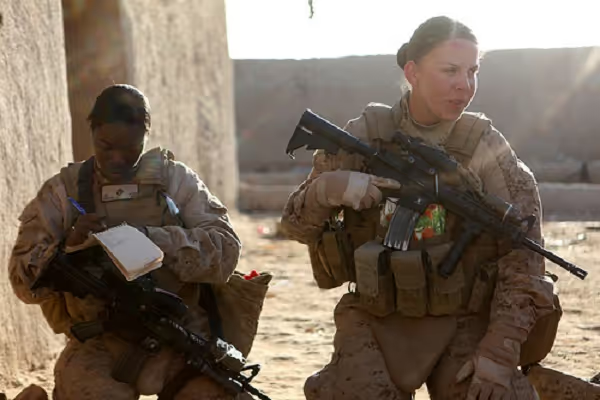The term “military-civilian divide” is often used to point out the isolation of the less than one percent of our population who are serving in the military, the seven percent who have ever served, and the unawareness from those who haven’t.
Personally, I see this divide growing larger than ever before, as we become further removed from the full realities of war. As Mike Haynie from the Institute for Veterans and Families at Syracuse University stated, “We’ve disconnected the consequences of war from the American public.” We’ve created a wall of a divide and we can’t tear it down without addressing the needs of all veterans when they return home to their communities.
The “military-civilian divide” is doubly true for women veterans who have for too long been under-served or excluded from veteran status, services, and culture. Women veterans risk falling through the cracks as they face both a country that doesn’t understand them and systems which are not gender appropriate. They’ve had to navigate a system-of-care built for men, by men, without regard to gender-specific needs for too many years. While we’ve made meaningful progress by rescinding combat exclusion policy and shaping services for women, we’ve got a long way to go.
Tailoring programs for women is crucial to their transition from the military to civilian spheres, to the nation’s support of women in service, and to ensure that their traumas are addressed. Women veterans die by suicide at six times the rate of non-veteran women, and we still don’t know which mental health and suicide programs are best addressing women’s mental health both in and outside the VA. (The Female Veterans Suicide Prevention bill, HR 2915, would require the VA to research which programs are most effective for women veterans.) The VA has made tremendous strides in advancing women programs and initiatives, but we need to scale these programs to address the mental health and wellness needs of women wherever they need to be met, both at the VA and in communities.
Many women veterans do not self-identify as veterans, or seek care through veteran or military entities. Some want to erase their service and veteran identity from their own personal narrative because of the traumas they’ve endured. Some may be prideful of their service even if that service placed them in a traumatic situation; but angry at the nature of the events. As a result, three out of four women veterans seek services in the community which is understandably ill-equipped to recognize the specific issues they face or the resources available to them.
From 2013-2014 I helped manage the California Women Veteran Project, funded by The California Wellness Foundation, which provided resources to veteran and non-veteran service organizations to build capacity, improve services for women and identify best practices within their programs.
It used a new approach; in fact it was the first and only funding project of this kind in California and the country. Using a macro lens, we engaged with organizations throughout the state that were unable to serve women veterans, unaware they were currently serving them, or were serving them without tailoring programs to meet their specific needs apart from men.
Swords to Plowshares awarded grant funds to 22 organizations throughout California providing a broad array of services including health, mental health, housing, legal assistance, rape crisis support, family support, and employment. CWVP project partners provided 1,837 women veterans with direct health and wellness services, and engaged in outreach and community education to 3,965 women veterans. Our impact report highlights common challenges and best practices based on the experiences and lessons learned from 22 CWVP organizations. Among the recommendations for improving the system of care for women veterans:
Dispel myths and assumptions regarding women in service and what supports should be available
Prevailing attitudes regarding women in service, and disturbingly, attitudes of rape culture, are real, and still exist even after women have been fully integrated in military services.
“The program’s focus on sexual violence and veterans was on occasion ill-received by other veteran-serving agencies. And that they ‘had to work diligently to dispel common myths about military sexual trauma and to overcome barriers to accessing the veteran community, given the wider societal attitude to sexual violence and silence surrounding the issue…” – a CWVP grantee
Provide support where needed rather than where we presume women should go for care
Women may have very good reasons for preferring the civilian system-of-care; and while we should encourage them to seek services in which they are eligible at the VA wherever appropriate, they should not forfeit access to culturally competent care in the civilian system because of their service.
Create linkages among community providers to increase referral system and share best practices
Women organizations and veteran organizations work in silos, and providers must begin a dialogue around specialty care to coordinate a treatment response that takes into account the whole veteran and her complex needs.
Implement appropriate screening methods to identify women veterans
Many providers don’t ask if their clients served in the military, and are unaware that many women seek medical care from civilian healthcare facilities. Others who do implement screenings may not be familiar with the appropriate terminology to ask in order to receive the correct information.
If providers do not ask the initial intake questions, ‘Have you ever served in the military?’ they will likely miss connections when a patient discusses health issues such as depression, anxiety, and pain associated from an injury during their service. Without context of service, civilian providers do a disservice for veterans by not acknowledging that symptoms may be related to their service. – Vanguard University, Global Center for Women and Justice
Separate the trauma from the veteran and dispel assumptions among providers of the woman veteran’s experience
It is important as a treatment provider and advocate to distinguish the woman veteran from the trauma she has experienced. Often to be a “victim” is counter-intuitive to being a “warrior.” Women may struggle with this and it may impact their care seeking behavior.
Apply a culturally-informed practice and approach
In order to effectively support veterans, practitioners need to explore the culturally-based constructs of the warrior mentality or worldview, and how this construct interacts with perceptions of trauma and affects their help-seeking behaviors in general. Providers must develop workable, gender-appropriate and responsive solutions.
I believe the impact of this grant will have longer reaching effects than initially anticipated. The impact of cultural competency trainings and technical assistance we received will ripple into our programs for many years to come. The ability to put a human face to the complexities of women veterans has been invaluable as we continue our work in the community, and interact with these families. – South Bay Community Services
Create a movement for women veteran care in California and throughout the nation
Generations of fraternal supports and services have excluded women from the resources and benefits associated with past service. Service providers, academics and researchers, philanthropists and government have all recognized the need for improvement but struggle to develop strategies and secure funds.
This funding project, the first and only of its kind, has only scratched the surface of dialogue among providers, advocates, and the philanthropic community. But more needs to be done to improve women’s health and wellness, and to continue the movement to meet women veterans at every corner of the California (and nation’s) map.
Megan Zottarelli, Senior Analyst for the Institute for Veteran Policy at Swords to Plowshares, manages research and data analysis of issues pertaining to veteran healthcare access and treatment quality; leads public education efforts, including an online behavioral health training series for providers and advocates which explores the intersection of mental health and social justice issues among veterans; and writes curricula and publications for behavioral health providers. She has a long history working on mental health issues among underserved populations. Megan received her BA in Psychology and MPA with emphasis in Policy Analysis from San Francisco State University.


.png)
.png)


